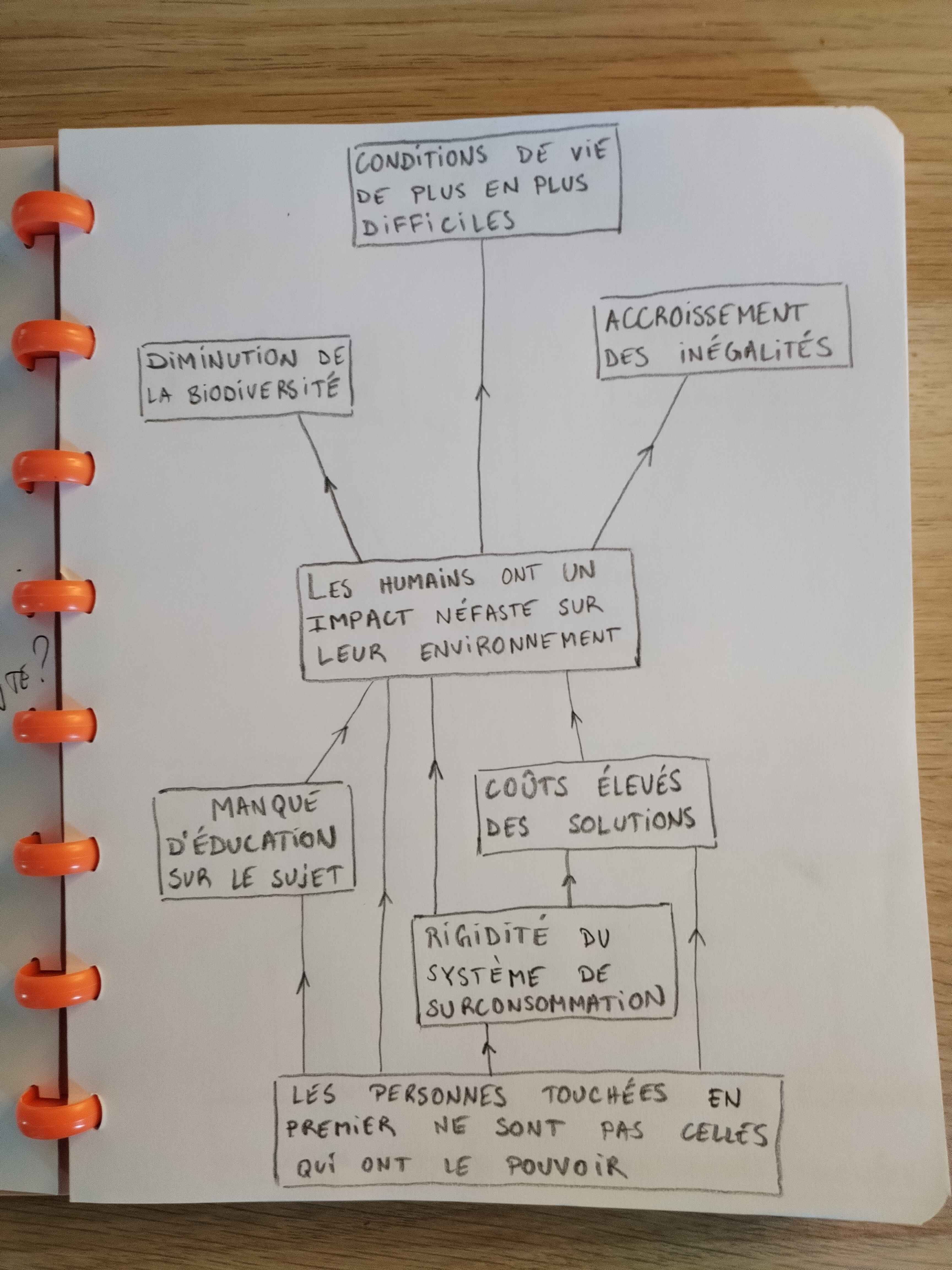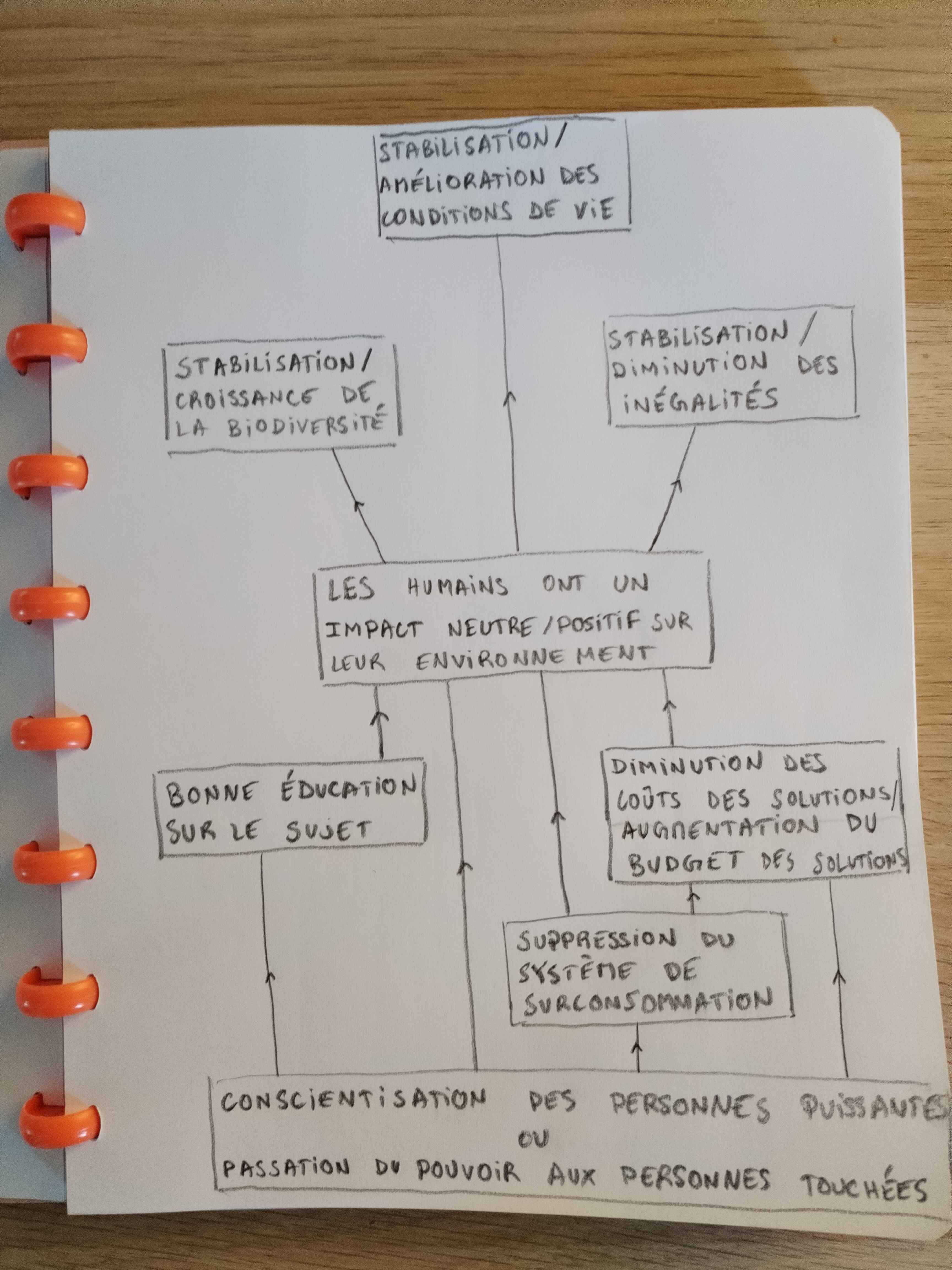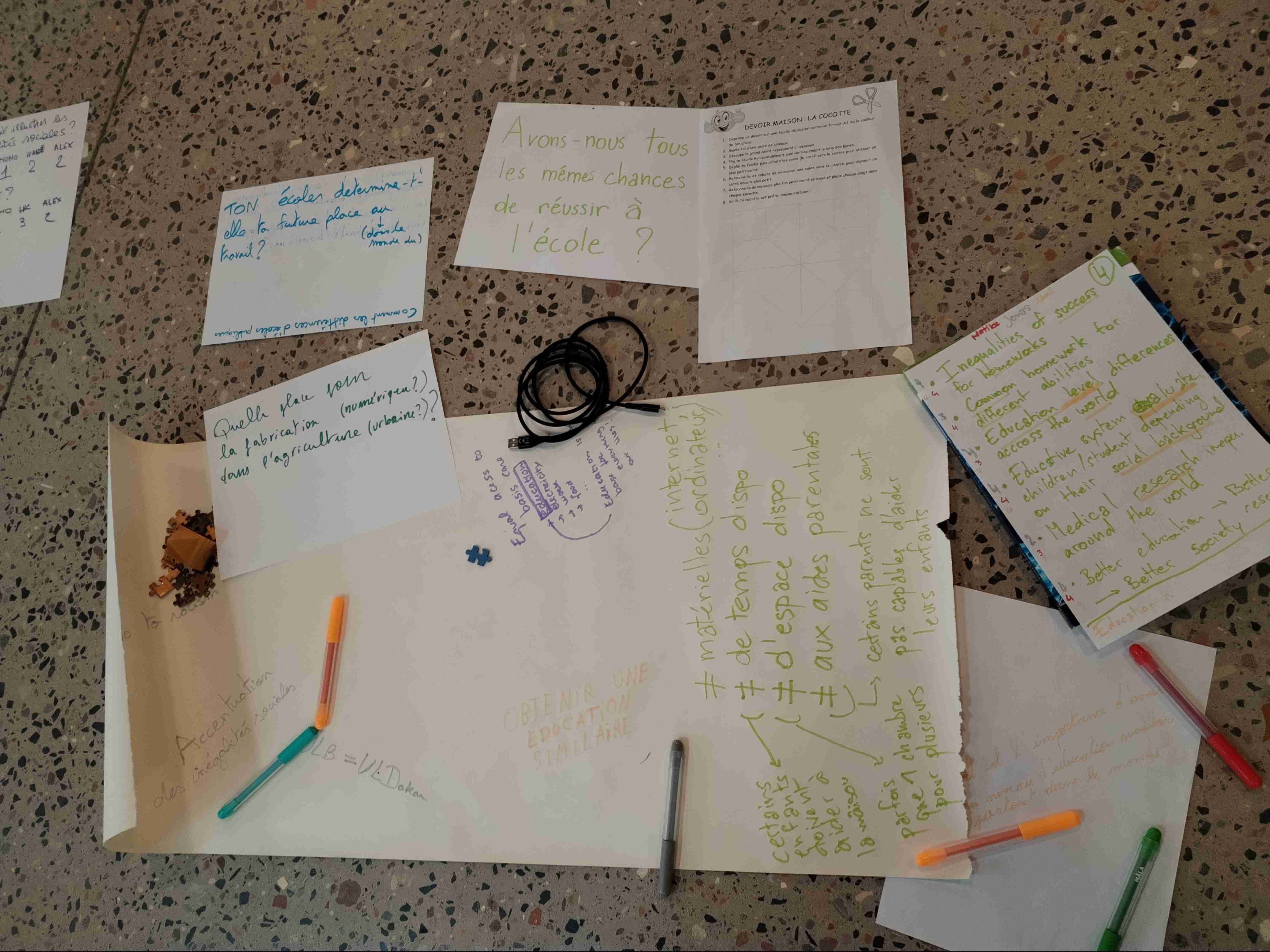5. Group dynamic and final project#
This final module documents the group and issue emergence process.
Frugal science introduction class#
During our third class, we were introduced to the frugal science philosophy.
We had a small homework to do before class. We were asked to take inspiration from some frugal science projects and the former FabLab projects in order to choose a project that we will present shortly.
I chose the Planktoscope which is a “modular, open-source hardware and software platform” (but also small, ease of use and cheap) that allows to study plankton samples and population. Plankton is actually quite important in the global biodersity cycle and understanding it is crucial in understanding the world around us and the effect we have on it.
The goal of the homework was then to build a problem tree and a solution tree related to the project we chose. According to me, the root problem on which the Planktoscope tries to act is “The human have a harmful impact on their environment” and it led me to construct the following problem and solution trees :


The Planktoscope, first of all, studies the human’s impact on his environment. Therefore it directly acts on the lack of education about the subject.
By his cheap aspect, it also acts on the “high costs of solutions” since studying the impact of humans on their environment is a first step to get this impact better although it is not a direct solution to transform the impact.
“Bring an object that connects”#
Before the first real Group dynamic class we had one task to realize. We were asked to think about an issue we care about and to bring an object that illustrates the issue while being related to the theme “an object that connects”.
What am I interested in ?#
This first exercise was not an easy task because you start from nothing. To structure a bit my thinking process, I started by noting the things I’m interested in :
- Physics
- Mathematics
- Coding
- Crafting
- Video games development
- Visual Art
- Music creation
- Social sciences
- Politics
- Education
I realised that these subjects could be ordered in a way :
- Logical thinking
- Physics
- Mathematics
- Coding
- Creative thinking
- Crafting
- Video game development
- Visual Art
- Music creation
- Human relations thinking
- Social sciences
- Politics
- Education
But I was not convinced at all by that ordering since it was too separative and discrete. Indeed “Logical thinking” subjects also need “Creative thinking” or “Human relation thinking” and vice versa. I would prefer a representation where these three ways of thinking are the summits of a triangle and all of the subjects I cited are located somewhere in the triangle where the center would correspond to something that equally needs the three.
This representation allowed me to realize that I feel really strongly attracted by the center of this triangle. Indeed, when I think about how I would like to approach every one of the subjects of the list, I’m always looking for a way to get the subject closer to the center.
What issue do I want to work on ?#
After I could tell much more clearly what I am intersted in and why, I had to think about an issue I would like to work on. At first sight, it seemed easier to me to look for a social issue I care about and try to introduce logic and creativity in its resolution rather than the opposite.
Since my mother is working in a literacy association, I tried to think about the issues faced by her students and I rapidly remembered that she pretty often talks about the difficulty her students’ children experience in their education and development. The difficulties I remember are :
-
Lack of time
Sometimes, the parent is single (mostly single mother) and have to take care of many children at the same time hence the older ones often need to help. They thus lack of time to study, do their homeworks or even have fun.
-
Lack of money
This one is pretty obvious. These families are not rich at all so they sometimes can not afford education material as books, private teacher, computer, etc. but also entertainment material as sport club, video-games, creative activities, etc.
-
Lack of space
It is related to the previous point. They mostly live in small appartments and multiple children share the same bedroom. It is not easy to study or relax in the same room as a toddler or a young child.
-
Lack of parent-child communication
Finally, the parents grew up in a different country than their children. The children evolve in different cultural environment which, added to adolescence, can rapidly lead to communication issues and create a conflict environment which is firstly not appropriate for the child development and then does not allow the previous points resolution through communication. Furthermore, the parent sometimes works late and is not even available for communication.
These points motivated me to work on the inequality of opportunities at school which concerns obviously a larger set of families than the ones whose parent(s) is(are) illiterate(s).
How can I represent the issue with an object ?#
I wanted to find an object that illustrates all of the aspects of the issue I cited above : an object related to school which illustrates inequalities related to time, money, space and communication. In other words, I wanted to find something related to school that requires time, money, space and communication with a parent. For some of you, it maybe rang a bell :
Homeworks
In order to do his/her homeworks correctly, a child needs :
- the time to do it
- the required material (sometime even a computer)
- the adequate space (most of the time a calm space)
- help from his/her parents
So I made what seems to me a typical crafting homework a child could get during his first years of basic school :
In order to be correctly done, this crafting homework needs :
- the time to do it
- scisors, coloured craft-paper, a printer to print the homework on the coloured paper
- an adequate space
- help form parents to use the printer and understand the instructions since they are not really clear
The inequalities of opportunities at school are quite obvious here. As mentionned before, all children do not have the time to do it, the required material, the adequate space and I insist on the last point that seems the most important one to me, they do not all have an available parent to help them. The latter could be busy taking care of all of the other children, at work or sometimes they don’t even speak the language in which the homework is written.
However, homework is often presented as a way to practice, discover, try to think by yourself and even sometimes to evaluate. In other words, an educative system using homeworks without considering inequalities completely contributes to social determinism and does not give the same opportunities to every children.
First group dynamic session : Group creation and Brainstorming#
The objectives of the first group dynamic course were :
- Form work groups
- Create a list of issues for each group
To complete these, the course was divided in three parts :
- Warm up
- Group creation
- Brainstorming
This first part was composed of small games similar to the ones we played during the “break the ice” sessions.
During the second part, in order to create coherent group in a quite spontaneous way, we first had to discover each other’s object. We were asked to put our object on the floor and to wander in the room while observing the other’s objetcs. We had to identify three objects that intrigued us. I spotted :
- An academic physics book
- Pieces of puzzle
- A screwdriver
The next instruction was to write a question that illustrates our issue on a sheet of paper and to put the latter next to our object. I wrote : “Do we all have to same chance of success at school ?”. We then had to repeat the first exercise by also taking the questions into account. The questions associated to the objects I spotted were :
- Academic book : How to equalize the education level between the different countries of the world ?
- Pieces of puzzle : Do we all have the same chances of success in the professional world ?
- Screwdriver : Ho to make people more efficient ?
I was glad the two first issues were obviously related to mine but I found the third one too dependant on the meaning of the word “efficient”, which is really subjective and culturally dependant and could then be quite opposite to the issue I came with.
After identifying which objects had been brought by who, we had to wander again and to get close to the people whose issue interested us. We rapidly formed a group of three with Mohamed and Noah who respectively brought the pieces of puzzle and the academic book. Robin, who brought the screwdriver, was not far from us but hesitated to come with us. Since we could not talk, I guess he was not sure we were on the same page.
The groups were not yet definitive so we were asked to visit other groups and to ask about their issues. At this point, since she liked a lot our issues, Matilde joined us althoug her object was not related to ours.
The groups were still not definitive and we had to brainstorm without debating by writing on a large sheet of paper everything we thought about when thinking about our issues. Robin finally decided to join us, so we were now five. By thinking about how he used the word “efficient” to describe his issue, I was a bit scared that we did not share a common objective and common social values but after a long discussion we understood each other and I was reassured.

We then had to choose one of us that would present our issues and brainstorm to the others while everyone would do a final check of every group to be certain of the group we want ot be in. I did the presentation and I think at this point Altay realised he would prefer to work on issues similar to ours. Since hes was in a group of three, we were five, and we had to form groups of four, Mohamed joined Altay and his group to work on issues related to ours.
Our final group was then composed by :
and the list of problems we identified as a group is :
- Do all the pupils/students have the same chances of success while doing a homework ?
- Why are all the pupils/students evaluated on the same way although they have different skills ?
- Is it fair that the educative system’s evaluation’s result depends on the social background of the evaluated student/pupil ?
- Why are they different education levels accross the world ?
- Is it fair that the education level of a country defines the ability of the country to have access to good medical research ?
Second group dynamic session : Tools to colaborate#
The groups were defined and although our group project was not clear yet, we learned some tools to colaborate.
The course was conducted by a specialised trainer in group dynamic. The main points of the course were :
- How to work together
- How to decide together
- How to communicate together
- What roles are necessary for a group to work
- How to distribute these roles
- How to distribute the word
- How to give a feedback
The three tools that I liked me the most were :
-
Motivated fingers :
When one suggests something, everyone indicates how much he likes the proposition by showing one to five fingers. It allows to evaluate easily the motivations levels of each other. It can be usefull to make a choice, make a decision or to distribute roles.
-
Emotions meteo :
At the beginning or end of a meeting, we ask each other the simple question “How are you ?”. We do not have to go deep into details, we can express our emotions in a simple way. It first helps the others to adapt easily their behaviour depending on the expressed feelings, it then helps the questionned persons to drop their emotions aside to start the meeting on a better basis and finally, at the end of a meeting, it helps spotting who felt he or she was not able to epxress his/her ideas.
-
Consensus/Consent decision making :
In order to make binary decisions, we learned the subtle but important difference between consensus and consent. The consensus decision making would require everyone to agree with the decision. It results in a more motivated and convinced group but it can sometimes take a lot of time to find a consensus.
The consent decision making requires that no one disagree with the decision. The difference is that stopping a consent based decision would require one to clearly disagree with the suggestion which is less frequent than someone who does not clearly agree. It results in a less motivated group but allows faster decision making. It can be really usefull for fast decision or for decision that do not need everyone to be motivated.
